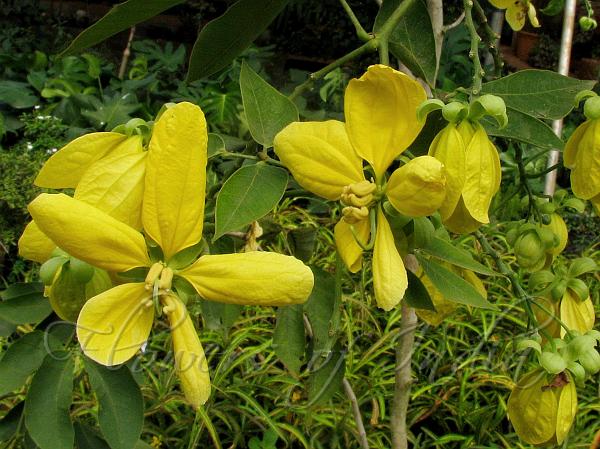|
| Large-Flowered Cassia |
|

|

| File size | 974948 |
| Original date | 12/1/13 12:14 PM |
| Resolution | 2048 x 1536 |
| Flash | Flash did not fire, auto |
| Focal length | 6.0mm |
| Exposure time | 1/125s |
| Aperture | 3.5 |
| Focus Distance | |
| Metering Mode | Multi-segment |
| Camera make | Canon |
| Camera model | Canon PowerShot S5 IS |
| Sensor type | OneChipColorArea |
|
|
|
|
Photo: |
Botanical name: Senna macranthera Family: Caesalpiniaceae (Gulmohar family)
Synonyms: Cassia macranthera
Synonyms: Cassia macranthera
 Large-Flowered Cassia is a weak leaning or runner
bearing, or more often erect and bushy shrub or treelet, at maturity
1-3 m and slender trees of rapid growth, reaching a trunk 6-15 cm in
diameter. Leaves below inflorescence are 2-26 cm. Distal pair of
leaflets are obliquely lanceshaped-elliptic to ovate or obovate,
varying from short-tapering blunt to triangularly pointed 1.8-16 x .8-6
cm, about 1.8-3.5 times as long as wide, with asymmetric base which is
heart-shaped or rounded or broadly wedge-shaped, with a midrib with
6-12 pairs of veins. Flowers are usually borne in panicles.
Flower-cluster-stalks, together with raceme axis, are 2-7.5 cm, the
latter 3-14-flowered; bracts lanceshaped, triangular,
lanceshaped-ovate, or elliptic-inverted-lanceshaped 1.3-4 mm, falling
off early. Buds are spherical, finely velvet-hairy, sepals either firm
or somewhat membranous, often yellowish or pallid or pallid-edged,
strongly graduated, in outline broadly obovate to nearly round to
elliptic-inverted-lanceshaped, the largest of the inner ones 4-14.5 x
1.8-8 mm. Petals are finely velvet-hairy dorsally especially along
veins, homomorphic except for the often slightly wider upper one and
for one lower slightly more oblique, all contracted into a slender claw
2-4 mm, the blades varying from broadly obovate to
oblong-inverted-lanceshaped, all blunt, the longest 2.5-4.5(-5) cm.
Stamens are of varying length, up to 9 mm, anthers 4-10 mm,
style 1.5-5 mm, little
dilated at tip. Pod are drooping or (when short) irregularly
spreading, the beak 4-9 mm, the nearly cylindroid body straight or
sinous 6-26 x 0.6-1.4 cm. Large-Flowered Cassia is native to Bolivia,
Brazil, Colombia, Ecuador, Paraguay, Peru, Venezuela, cultivated
elsewhere.
Large-Flowered Cassia is a weak leaning or runner
bearing, or more often erect and bushy shrub or treelet, at maturity
1-3 m and slender trees of rapid growth, reaching a trunk 6-15 cm in
diameter. Leaves below inflorescence are 2-26 cm. Distal pair of
leaflets are obliquely lanceshaped-elliptic to ovate or obovate,
varying from short-tapering blunt to triangularly pointed 1.8-16 x .8-6
cm, about 1.8-3.5 times as long as wide, with asymmetric base which is
heart-shaped or rounded or broadly wedge-shaped, with a midrib with
6-12 pairs of veins. Flowers are usually borne in panicles.
Flower-cluster-stalks, together with raceme axis, are 2-7.5 cm, the
latter 3-14-flowered; bracts lanceshaped, triangular,
lanceshaped-ovate, or elliptic-inverted-lanceshaped 1.3-4 mm, falling
off early. Buds are spherical, finely velvet-hairy, sepals either firm
or somewhat membranous, often yellowish or pallid or pallid-edged,
strongly graduated, in outline broadly obovate to nearly round to
elliptic-inverted-lanceshaped, the largest of the inner ones 4-14.5 x
1.8-8 mm. Petals are finely velvet-hairy dorsally especially along
veins, homomorphic except for the often slightly wider upper one and
for one lower slightly more oblique, all contracted into a slender claw
2-4 mm, the blades varying from broadly obovate to
oblong-inverted-lanceshaped, all blunt, the longest 2.5-4.5(-5) cm.
Stamens are of varying length, up to 9 mm, anthers 4-10 mm,
style 1.5-5 mm, little
dilated at tip. Pod are drooping or (when short) irregularly
spreading, the beak 4-9 mm, the nearly cylindroid body straight or
sinous 6-26 x 0.6-1.4 cm. Large-Flowered Cassia is native to Bolivia,
Brazil, Colombia, Ecuador, Paraguay, Peru, Venezuela, cultivated
elsewhere.
Medicinal uses:
 The plant is reputedly used in
the treatment of syphilis.
The plant is reputedly used in
the treatment of syphilis. | Identification credit: Prashant Awale | Photographed in cultivation in Maharashtra. |
• Is this flower misidentified? If yes,